INDEX
Aho and Whenu
(Weft and Warp)
| A Personal point of view Page 22 of the book "The Art of Maori Weaving" by Miriama Evans & Ranui Ngarimu (see book list on this site) contains one sentence that specifically caught my eye. It reads:- "Commercially prepared fibre is sometimes used by a weaver instead of muka, but extensive use of this type of fibre tends to diminish the cultural value of the garment." Although I understand and fully agree with that concept, it also depends on the context in which this statement is perceived. The cultural value is part of the Aotearoa/New Zealand identity, without question. The author is obviously talking about traditional kakahu, but the unwritten inference is that the cultural value of ALL woven items is diminished by the use of non-traditional fibres. It is certainly true that the use of traditional materials, e.g. harakeke, always adds a dimension to the finished piece that somehow cannot be attained with non-traditional materials. With the resurgence of interest in the weaving arts, the original, natural fibres also re-gained popularity, and while that is the ideal, ofcourse, realistically it's not always feasible for every weaver. To be honest, I pondered and fretted over this for many years, and for a long period I questioned whether my weaving was perhaps not legitimate or not valid because I do not use traditional materials. But then along came the exhibition for which the book cited above was written, "The Eternal Thread Te Aho Mutunga Kore" with it's glorious works of art. Interestingly, some artists showed kete and items of clothing made with copper wire or silver wire and shells. Not wearable garments, they were, however, artistically intriguing, innovative and imaginative... Years earlier, when Master Weaver Mrs Emily Schuster (who was the head of the weaving center at the New Zealand Maori Arts and Crafts Institute in Rotorua when I visited there in 1991) personally recommended "baling twine" to me as a good alternative to muka or harakeke, I truly believed she was very open minded on the subject of "traditional materials" versus "non-traditional materials". Her encouragement was PRICELESS - - - and the very same aforementioned exhibition also includes several of her beautiful creations as well. I will never be a famous or master weaver but I enjoy what I do, and it brings it's own rewards. While I do not advocate that people should go off and willy-nilly use alternate materials, for my personal circumstances, residential and financial, my current fibre choices for both weft and warp - aho and whenu - are discussed in the following paragraphs. AHO Stranded Embroidery Cotton (called "floss" in North America). This is the fibre I learned how to weave taniko with in 1959, it is still my first choice all these years later, and almost all of my weaving, both taniko and whatu, is done with this thread for the aho. It is an old and trusted "friend". Stranded cotton is easily obtainable (depending on the brand), it is relatively inexpensive and there is a good selection of colours from which to choose your preferences. Because this thread has a great "spreadability" factor, i.e. how it covers the whenu when twined around each strand, this thread works well with almost all twines used for whenu, but exceptionally well with black macrame twine and the hemp twine. A number of brands are available, specifically DMC, Anchor, J & P Coats, as well as a number of inexpensive Chinese brands now beginning to appear on the market. Stranded Embroidery Rayon If you like shine and shimmer, then this is the thread for you. It is often used to make souvenir type items. Rather than using this for a complete item I use it for specific highlights on certain patterns, e.g. to simulate paua shell, when I use it with a small amount of metallic thread mixed in with it and it offers a superb thread for such highlights in a piece of weaving. It is quite expensive, and one also needs to shop at a specialtly needlework store for it. The brand shown here is Marlitt and it's properties are similar to the stranded cotton. Knitting Cotton I have only used one brand of this thread. It weaves beautifully, and you can see the results in the two candy dishes shown in the gallery page. Some threads seem to completely thin out when being used, but this thread really holds it's shape and it's twist very well. This thread is slightly thicker than the stranded embroidery cottons, and it works very well with thicker whenu, e.g. jute twine. It costs about $5 per ball in Canadian funds, but one ball goes a very long way. The brand is Patons "Grace" shown here. Perle Cotton This thread is an unknown to me at this time for it's weaving properties, and have yet to weave something with it. Because of it's mercerized properties it should weave very well and give a very nice finish to the woven piece. Each skein is the equivalent of three skeins of stranded cotton, but one skein of Perle thread is twice the combined cost of those three skeins. Therefore I don't buy it very often. I have used it for other projects, all embroidery or stitching, but it was never my first choice of thread. From DMC, Anchor, and several inexpensive Chinese brands. Chainette Similar to Japanese bunka, this is an interesting thread, also from Japan. It is somewhat like crocheted chain, and is actually used to make tassles, etc, because of it's excellent drape and flexability. All the headbands I made that went to the 1992 World Indigenous People's Conference (shown at the bottom of Gallery page) were made of this fibre. It comes on cones and is apparently 100% Exlan (acrylic). The four cones I own of this thread were purchased in New Zealand in 1991 and it was relatively inexpensive at that time. The one caveat with this thread is that it is very hard on the skin and will cause blisters and broken skin on the fingers of your weaving hand. However, I find this thread is excellent for decorative paheke running thread rows. WHENU #5 Macrame Twine Like the stranded embroidery cottons this twine is also an old friend. It is what I learnt to weave taniko with. It is highly mercerized and therefore holds together very well during the weaving process. The thickness ratio between this twine and the stranded cotton is a perfect combination. Now slightly thicker than it was when manufactured in the UK by Strutts, the size of the ball remains approximately the same (50 yards, 45 meters) but the price has skyrocketed over the years - it was originally 5/- (5 shillings) in 1959, in 1991 it was approximately $6.95 per ball and it is now in the range of $12 to $14 per ball. My "stash" of this twine is more precious than gold. Hemp Hemp is a distinct variety of the plant species cannabis sativa L. It is a tall, slender fibrous plant similar to flax. Farmers worldwide have harvested the crop for the past 12,000 years for fiber and food, and Popular Mechanics once boasted that over 25,000 environmentally friendly products could be derived from hemp. Unlike marijuana, hemp contains only minute (less than 1%) amounts of tetrahydrocannabinol (THC), the primary psychoactive ingredient in marijuana. In addition, hemp possesses a high percentage of the compound cannabidiol (CBD), which has been shown to block the effects of THC. For these reasons, many botanists have dubbed industrial hemp "anti-marijuana." This is one of my preferences for weaving these days. The 48lb weight twine is perfect for whenu, although for small, finely woven pieces the 20lb weight would also work well with a thin thread for aho. There are two brands available in my local store, one from Hungary and one from Romania and I tend to prefer the latter for it's slightly lighter colour which is more flax-like. An interesting fibre to use and while not completely ideal (there are some occasional inconsistencies in the thickness of the twine) it is considerably better than most other fibres I've experimented with, and the finished item looks and feels is similar to authentic muka. Kitchen string (Butcher's twine) This is my other preference for weaving. There are a number of different twines or strings that fit into this category. Some are tightly twisted and mercerized and are almost exactly like the #5 macrame twine (almost the same thickness, as well) while some are little more than soft candlewicking (also known as mop cotton) and do not hold up at all well in the weaving process. In the not too distant future I plan on experimenting with dyeing this twine. Since it only comes in white, I would like to see if I can dye it black and maybe one or two other colours. Jute and Sisal Neither one of these is a personal preference. Sisal is similar to muka and I am now of the opinion that I may not have given it a fair and decent trial. I had a couple of "disasters" when these twines didn't work out very well in the projects I used them for. It's on my list of things to try or re-try at some point in the future. |
 ALTERNATE TWINES AND THREADS 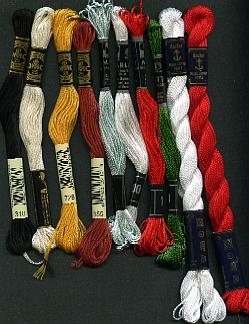 Image shows a selection of threads, e.g. stranded embroidery cotton, stranded embroidery rayon and perle cotton 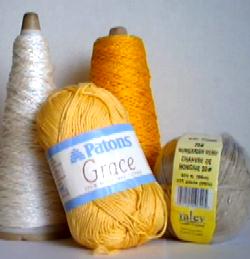 Chainette, knitting cotton and 20lb hemp 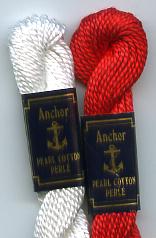 #5 Perle cotton 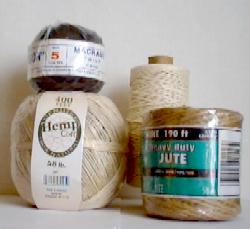 A selection of twines suitable for whenu including #5 macrame twine, 48lb hemp, jute and kitchen string. 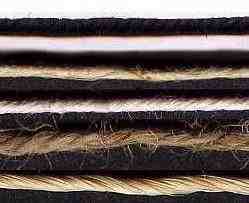 Closeup of whenu twines (top to bottom) macrame twine (on white background), hemp, kitchen string, jute and sisal. 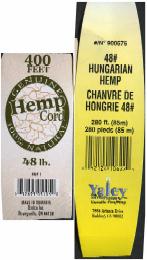 Labels from balls of 48 lb weight hemp twine from Romania and Hungary. |
Copyright 2006 (�), Judy Shorten